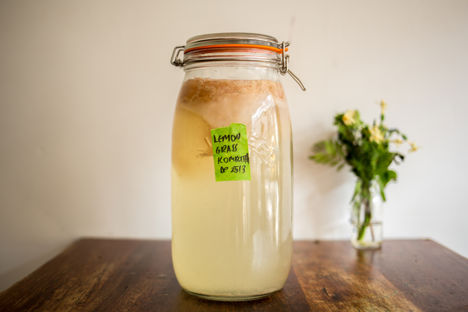Kombucha is a slightly sparkling sour tonic beverage, similar to the popular Russian drink kvaas (which is made from fermented rye bread). Kombucha, however, is a fermented, sweetened tea, cultured with a SCOBY (Symbiotic Culture of Bacteria and Yeast) which as the name suggests, is one big wobbly culture made of all manner of bacterial goodies. SCOBYs have garnered quite a reputation amongst kombucha-lovers for their somewhat unappetising appearance – once one's been floating in the tank a while, it’s a rather terrifying looking thing that wouldn’t look out of place in any of the Alien films. SCOBYs are beautiful things though – full of nutrients with a texture and flavour somewhat similar to lychee. They float in the tea solution, left to feed off the sugars in the tea, creating a slightly sparkling liquid with minuscule levels of alcohol.
Kombucha is said to have originated in China and has become popular in many countries since, particularly the USA. More recently it's been grabbing attention on these shores, thanks to a wave of interest in healthy probiotics. Although some of the more outlandish health claims surrounding kombucha haven’t been proven, the ‘good bacteria’ in the beverage is good for the immune system – though if you’re drinking shop-bought, make sure it hasn’t been pasteurised or all of the good bacteria will have been killed!
Kombucha shouldn’t just be left for the health-conscious, though – its unique flavour is being embraced by inventive chefs searching for new, exciting flavours to add to their culinary repertoire.
The recipe below is from chef Dean Parker, head chef at The Manor in Clapham, who uses kombucha for all kinds of creative recipes; soft drinks, vinegars, sorbets, dressings and cocktails to name a few.
During his experiments in kombucha-making, lemongrass tea provided some of the best results, but don't be too wary of playing around with flavours: 'Earl Grey has been successful although the acidity levels rise quicker, despite the fact the mother usually tends to die off in other citrus teas. Green tea is another one we do weekly, as well as a dark roasted malt tea which we use to make vinegar (alternatively you could use roasted pearl barley).'
It should also be noted that homemade kombucha will contain some alcohol, which is a by-product of the fermentation. While commercial varieties are carefully treated and controlled to keep their alcohol levels at 0.5% or below, homemade kombucha can be 1–2% ABV.
How to make kombucha
Metric
Imperial
- 1l water, filtered
- 100g of sugar
- 4g of loose-leaf tea
- 1 kombucha SCOBY, these can be found online for around £10 and are re-usable (providing they are looked after!)
Variations
Aside from using different flavoured teas, you can flavour your kombucha by adding fruits and aromatics during the second fermentation – strawberry, ginger, elderberries, herbs, apple, spices and even lavender make excellent flavourings. Just make sure the SCOBY has been removed before adding any of the flavours as they can damage or even kill it.
Get in touch
Please sign in or register to send a comment to Great British Chefs.



